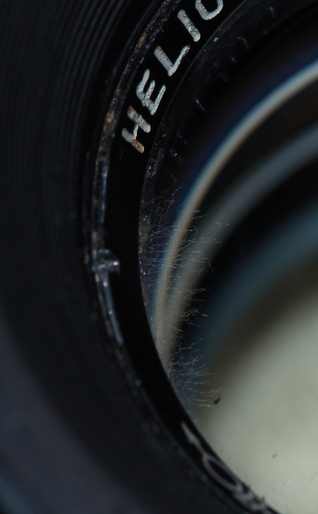Published Oct 25, 2013
Got a Helios 44-2. Nice lens. Pretty old (serial number may imply it's from 1979), but in decent condition; $30 shipped. It had a lot of dust and marks on both the front and rear elements, but they were very easily cleaned with MagicFiber-brand microfiber cloth which, frankly, lives up to its name - the thing is magical. (I got mine from Amazon; cheaper knockoffs may scratch the glass, so I wanted a reputable source.)
But it has fungus after the front element.


How do I open it up to get at it?
Published Oct 25, 2013
There's absolutely no point buying a $300 (or $3000) piece of glass and putting a $10 filter on it if the filter degrades the image. Obviously, a more expensive, higher quality, professional filter is the way to go. This is doubly true for a UV filter (or a clear filter - normal digital camera already filter UV, so it's used just for protection), since a common alternative is to use a hood, which doesn't add any glass in front of your lens.
Putting a filter on a lens adds another air/glass interface (or two!). This can result in blur, loss of sharpness, color distortion or shift, flaring and ghosting, and so on. For these reasons, there are certain situations where even the best filter absolutely destroys and image. Furthermore, certain lenses have front elements very close to the threads, and some garbage no-name filters actually damage the lens permanently!
But I would like to use a filter for protection against scratches, and I wouldn't like to spend a whole lot of money doing it. So I bought a 58mm three-filter Fotodiox Kit (UV, CPL, Soft Diffuser) from amazon. I paid $12 for it. I put it on my Canon EF 100mm USM macro, on a crop sensor camera (T3), and tried to spot any differences in quality, assuming no bright light shining onto the filter (so no purposeful flare/ghosting). Pictures and evaluation after the jump.
Published Oct 12, 2013
Yes, it works! Even though it's not officially supported in Magic Lantern v2.3, it works. It's awesome. It's also free open source software.
Have you ever looked at your camera and said - why isn't this function here? I know the hardware exists on the camera, and I know it's electronically controlled, and I know other features control it, so why can't we have a feature to control it in the way I want?
Oh, I know why - because apparently, an intervalometer (firing the shutter every x seconds) is reserved for the expensive cameras. Our plebaian camera can certainly fire the shutter electronically, but we haven't paid enough for the camera to keep firing it.
And so on and so forth. I completely understand the argument for partitioning the market. Everyone does it for an excellent reason: low-end sales are the bulk of the market, but if you give the low end all the features, nobody will buy the high-end. It doesn't make sense to give the cheapest $500 camera all of the professional controls demanded by people paying $3000 for a camera body. There's also no point writing separate operating systems; rather, just write one, make all your cameras work with it, and simply strip out some software functionality in addition to the actually different hardware.
But where I sit with my camera I can actually afford, well, wouldn't it be nice if I could get all the electronic features? Cue Magic Lantern.
Published Oct 10, 2013
I was wondering what the minimum focus distance switch does. Here's what it looks like:


I thought it was a mechanical lock to prevent you from focusing closer, but had no idea why. When I got to play with a lens that had this switch, I could still focus to minimum distance manually! Then I tried using AF and figured out what it's for:
The switch tells the camera auto-focus not to focus closer than what is selected. Helps the focusing algorithm work faster by eliminating some guesswork. That's it!